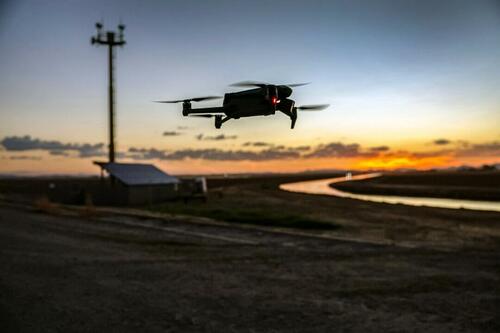
The Spiderweb & The Lion: Subversive Infiltration And US National Security
Authored by Andy Thaxton via RealClearWire,
Over a decade ago, when I was working on force protection issues for Navy air logistics missions, the threat of drone attacks was just beginning to be seriously discussed. We kicked around contingencies and “what ifs,” but those discussions were largely in the background of mission planning. Over the course of the past ten years however, that threat has exploded to the forefront of the military operational planning world and has presented something altogether new in modern warfare.

In the early hours of June 1, 2025, Ukraine’s Security Service (SBU) executed Operation Spiderweb, an audacious drone assault on Russian airfields that destroyed or damaged a number of Russia’s most prized aircraft, including possibly two A-50 early-warning planes and as many as a dozen strategic bombers. Drones, smuggled into Russia over 18 months and concealed in remote-controlled containers, were launched from within Russian territory, catching Moscow’s defenses off guard.
Just days later, on June 13, 2025, Israel’s Mossad orchestrated a similarly bold strike, dubbed Rising Lion, targeting Iran’s nuclear and missile programs. Mossad agents, operating covertly within Iran, established drone bases near Tehran and smuggled precision weapons to dismantle air defenses and eliminate key figures, including Revolutionary Guards commanders and at least one senior nuclear scientist. Allow me to emphasize, the drone attacks came from within Russia and from within Iran.
These operations quite possibly signal a new era of warfare: patient, subversive infiltration by committed adversaries willing to play the long game.
The United States—due to years of lax borders and insufficient oversight of foreign land purchases—is alarmingly vulnerable to such tactics, especially from a strategic rival like China, whose land acquisitions near U.S. military bases pose a clear risk.
Asymmetric Warfare Redefined?
Even for those who pay little attention to such things, it is hard to miss that Ukraine’s Operation Spiderweb and Israel’s Rising Lion represent a paradigm shift in modern conflict. Rather than relying on conventional military power, both operations leveraged covert infiltration, advanced—though not restricted—technology, and strategic patience to strike deep within enemy territory. Ukraine’s drones, assembled and concealed over months, targeted a multi-billion-dollar air fleet with low-cost, commercially adapted unmanned systems. The SBU’s operation—smuggling drones across borders and hiding them in plain sight—demonstrated how irregular tactics can cripple a nation’s strategic power.
Similarly, Mossad spent (likely) years infiltrating Iran to set up drone bases and move munitions into position, striking at the heart of Tehran’s nuclear program and eliminating critical personnel. These operations reveal the growing effectiveness of a new asymmetric warfare, where smaller actors, with a little creativity, can exploit the vulnerabilities of larger adversaries, potentially for dimes on the dollar. Drones costing mere thousands, or even less, can now challenge systems worth billions. To complicate things further, drones can be deployed en masse. Online videos of Chinese drone light shows are something to see—single controllers managing 10,000 or more small drones in remarkable displays of precision and agility. It’s not hard to imagine what creative military planners could come up with using such systems.
Besides drones being employed in the two operations, there was a common thread of time. Both Ukraine and Israel invested significant time in planning, exploiting weak internal security, and insider access. Ukraine’s drones were smuggled incrementally and hidden in trucks and shipping crates. Mossad’s operatives reportedly worked under the nose of Iranian intelligence, using civilian vehicles to transport weapons and establish covert launch sites. These examples reveal a chilling truth: a patient adversary embedded on a target’s soil can strike with devastating precision.
Is the US Vulnerable?
The United States, with its liberal immigration policies of recent years, and permissive foreign investment rules is ripe for similar subversion. The Committee on Foreign Investment in the United States (CFIUS) oversees foreign land purchases, but its mandate is limited and often fails to detect national security risks posed by strategic acquisitions.
A 2021 case involving the Chinese Fufeng Group’s purchase of 300 acres near Grand Forks Air Force Base in North Dakota sparked congressional concern. The base plays a key role in U.S. drone operations and intelligence, surveillance, and reconnaissance (ISR) missions—making it an ideal target for espionage or sabotage. Chinese firms have also purchased or attempted to purchase land near other sensitive sites, including Nellis Air Force Base in Nevada and Fort Bragg in North Carolina. Only within the past few years has this activity started to gain the attention of lawmakers.
Separate from land purchases, as early as 2019, public warnings of Chinese container ships potentially docking in U.S. ports with concealed drone launchers onboard have been raised. Such covert systems could be used to target military installations and sensitive infrastructure. Tom Shugart, a senior fellow at the Center for a New American Security (CNAS), emphasized this risk recently stating, “We routinely allow ships owned and operated by DoD-designated Chinese military companies to sit in our ports with thousands of containers onboard and under their control.”
China Is a Patient Adversary
China’s strategy mirrors the patience and subversion seen in Ukraine and Israel’s operations. Through the Belt and Road Initiative and a sweeping global investment program, Beijing demonstrates a long-term approach to gaining strategic leverage. The FBI has highlighted the use of shell companies to obscure Chinese ownership behind purchases, which could complicate oversight by CFIUS and state governments. These acquisitions, if unchecked, could provide ground for passive intelligence gathering and even launching attacks.
The threat is not merely theoretical. Security analysts are increasingly concerned about the possibility of PLA-aligned actors using assets on U.S. soil to disrupt logistics during a potential Chinese invasion of Taiwan. Drones launched from rural properties could target airfields, fuel depots, or command centers—just as Ukraine’s SBU did to Russia.
Closing the Gap
The United States must act decisively to counter this emerging threat. First, Congress should expand CFIUS authority to review all foreign land purchases in proximity to U.S. military bases. Second, the Department of Homeland Security must enhance port security and increase inspections of Chinese-flagged vessels for hidden weapons systems, as urged by CNAS. Third, the U.S. must elevate counterintelligence operations focused on subversive foreign networks—taking cues from Israel’s proven intelligence tradecraft. Finally, individual states must continue to pass legislation restricting foreign ownership of sensitive land.
Ukraine and Israel have demonstrated that patient, subversive infiltration can paralyze powerful militaries. China, through strategic land acquisitions and global ambitions, is already positioned to exploit America’s vulnerabilities. The question is no longer what if—but when.
Tyler Durden
Fri, 07/04/2025 – 22:45














